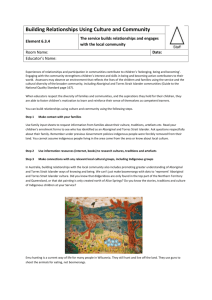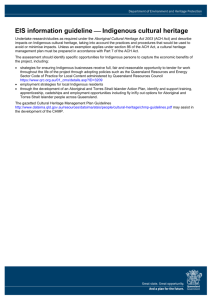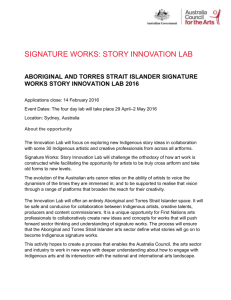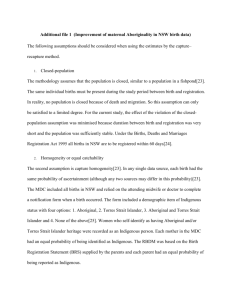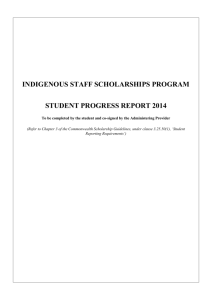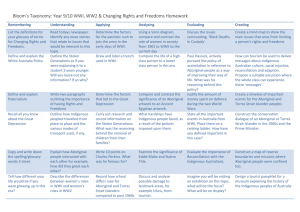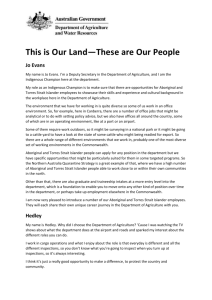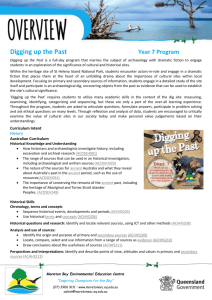Building Relationships Using Culture and Community
advertisement
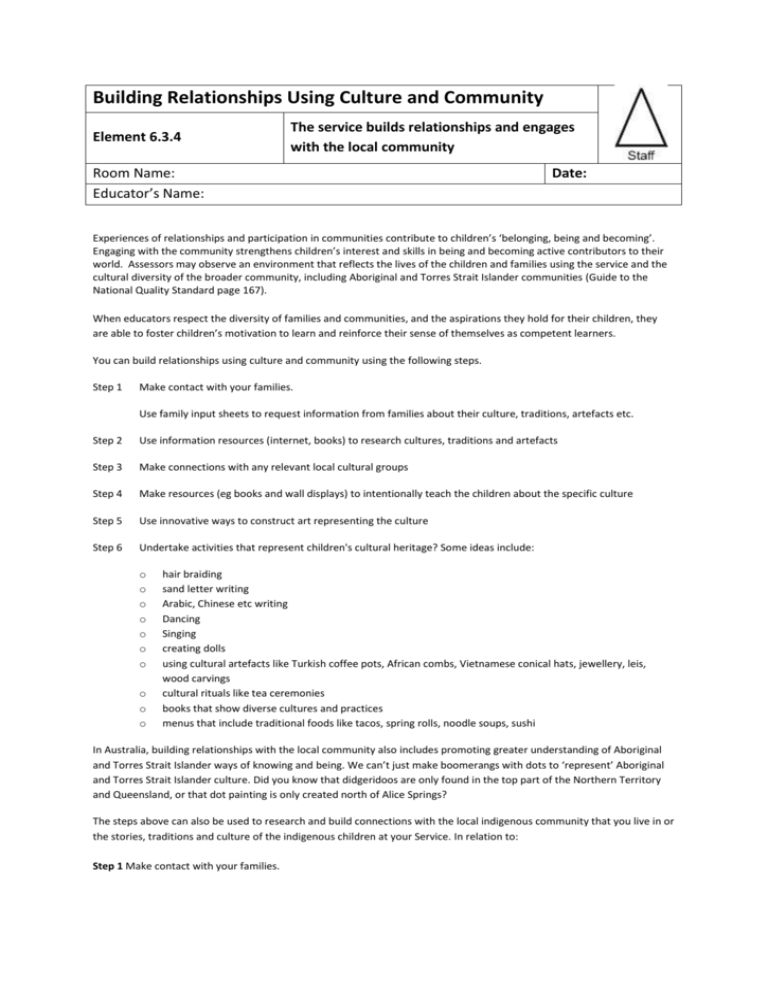
Building Relationships Using Culture and Community Element 6.3.4 The service builds relationships and engages with the local community Room Name: Educator’s Name: Date: Experiences of relationships and participation in communities contribute to children’s ‘belonging, being and becoming’. Engaging with the community strengthens children’s interest and skills in being and becoming active contributors to their world. Assessors may observe an environment that reflects the lives of the children and families using the service and the cultural diversity of the broader community, including Aboriginal and Torres Strait Islander communities (Guide to the National Quality Standard page 167). When educators respect the diversity of families and communities, and the aspirations they hold for their children, they are able to foster children’s motivation to learn and reinforce their sense of themselves as competent learners. You can build relationships using culture and community using the following steps. Step 1 Make contact with your families. Use family input sheets to request information from families about their culture, traditions, artefacts etc. Step 2 Use information resources (internet, books) to research cultures, traditions and artefacts Step 3 Make connections with any relevant local cultural groups Step 4 Make resources (eg books and wall displays) to intentionally teach the children about the specific culture Step 5 Use innovative ways to construct art representing the culture Step 6 Undertake activities that represent children's cultural heritage? Some ideas include: o o o o o o o o o o hair braiding sand letter writing Arabic, Chinese etc writing Dancing Singing creating dolls using cultural artefacts like Turkish coffee pots, African combs, Vietnamese conical hats, jewellery, leis, wood carvings cultural rituals like tea ceremonies books that show diverse cultures and practices menus that include traditional foods like tacos, spring rolls, noodle soups, sushi In Australia, building relationships with the local community also includes promoting greater understanding of Aboriginal and Torres Strait Islander ways of knowing and being. We can’t just make boomerangs with dots to ‘represent’ Aboriginal and Torres Strait Islander culture. Did you know that didgeridoos are only found in the top part of the Northern Territory and Queensland, or that dot painting is only created north of Alice Springs? The steps above can also be used to research and build connections with the local indigenous community that you live in or the stories, traditions and culture of the indigenous children at your Service. In relation to: Step 1 Make contact with your families. Read your children's enrolment forms to see who has identified as an Aboriginal and Torres Strait Islander. Ask questions respectfully about their family. Remember under previous Government policies indigenous people were forcibly removed from their land. You cannot assume indigenous people living in the area come from the area or know about local culture. In relation to Step 3 Make connections with any relevant local cultural groups Make contact with your local indigenous community. If you have no families that are of Aboriginal and Torres Strait Islander descent, or you would like to extend you understanding of indigenous traditions and culture, try and make contact with your local indigenous community Research local council websites Museums websites State government websites Land Council Federal Government websites In Google type in your suburb/town or location and Aboriginal and Torres Strait Islander peoples heritage or art. Below are some examples of sites Australia wide: http://www.australiaforeveryone.com.au/travel_dest_aborsites.htm This site lists the States' and Territories' art sites. Did you know 6000drawings, most of which were carved into sandstone rock faces, once existedthroughout what is now the Sydney metropolitan area. NSW: NSW Lands Council http://www.alc.org.au/media/28807/lalc%20contact%20details%2012.04.10.pdf Victoria: Victorian Aboriginal and Torres Strait Islander peoples Heritage Council http://www.dpcd.vic.gov.au/aboriginal-affairs/publications-and-research/aboriginalcultural-heritage-mini-posters Each indigenous people/area has its own cultural heritage. The picture below, for example, is from the Mob in Wilcannia, far north west NSW. This is a current way of life for many people in Wilcannia. They still hunt and live off the land. They use guns to shoot the animals for eating, not boomerangs. Connecting children to their communities and heritage provides numerous opportunities for educators to engage in intentional teaching. In this example, educators can extend the learning by discussing how: o they use the eggs for many different foods including cakes, scrambled eggs and omelettes. o o o o o o o o o they use the black, fatty meat they cook the emu in a hole. they dance the emu dance when celebrating. they use the feathers to make a basket or a charm and dream catchers. they carve the eggs and sell them. they use the fat for cosmetics they mix the fat with ochre to help relieve aches and pains. they know the emu is nesting when it appears in the Milky Way (May – June). female emus are bigger but the male sits on the nest.
